Cold noodles = warm hearts!
Naengmyeon: A Warm Love Letter to Cold Noodles
Introduction
Cold Noodles are Served Cold
Fight the Cold with Cold Noodles
Let's Eat Korea!
The Science of Cold Noodles
Pyongyang Naengmyeon is the Best
Warm Culture of Cold Noodles
We Sing of Our Boundless Love of Cold Noodles
Cold Noodles Becomes Warm Diplomacy
I Want to Eat Cold Noodles
Let’s Finish with Cold Noodles
Introduction
Cold noodles.
If you’re unfamiliar with this dish you are probably thinking of a fresh bowl of warm noodles, left to go cold in a corner of a dark kitchen (hang on, are they leftovers?) before being brought out to you and claimed to be a ‘local delicacy’. The thought of this has probably made you lose your appetite.
If you’ve had cold noodles before you’ll be familiar with the cool, tangy, spicy & chewy noodles. You may have enjoyed eating them, or you may have simply sampled enough to get a feel for the dish and decided two mouthfuls was enough.
Cold noodles, or naengmyeon in Korean, is much more than simply noodles served cold and for the uninitiated, not what you think they are. They are a dish that while eaten cold, is deeply intertwined into the history & culture of Korea, and in particular in North Korea. Cold noodles have even emerged as a powerful food able to inspire peace and make people to break out into song.
Let’s take a dive into cold noodles to gain a better understanding of the dish, its history and place in society.
Who knows, by the end of this you might just be craving a bowl of cold noodles!

Cold noodles before consumption
Cold Noodles are Served Cold
The name does not lie – these are noodles that are purposely served cold, sometimes even on ice. To understand why they are served cold, we need to look at a few factors including history, geography and science.
While no one knows for sure how cold noodles came to exist (ask the ancestors they say), many people believe the current form of cold noodles was created during the Joseon Dynasty (1392-1897) which was a period where Korea stepped out into the world to start international trade. This period saw Korean cuisine develop significantly as Korean traders ventured further out into the world and returned with new foods not seen or used before (hello chilli peppers). Many of Korea’s famous dishes evolved into their modern form during this time.
Some say though that the history of cold noodles goes as far back to the Koryo Dynasty (918-1392) with the Mongols introducing buckwheat to Korea. Buckwheat being grown in summer and harvested in autumn meant there was a plentiful supply well into winter. People would then make noodles using buckwheat flour and flavour their noodles with the frozen slush of radish water Kimchi from their earthenware pots they kept outside.
The north of Korea is the ancestral home of Korean cold noodles, with the cold noodles from Pyongyang and Hamhung being the most famous and sought after.
Fight the Cold with Cold Noodles
The approach to food in East Asia is very different to what we follow in the west, with the therapeutic effects of food playing a big part. This is a form of Chinese medicine whereby the effect generated by certain foods is the focus as opposed to their immediate effect on the body.
This idea of ‘food being medicine and medicine being food’ helped shaped the cuisine throughout East Asia for many centuries, and in Korea well into the time of the Joseon Dynasty.
In Korea, they call this ilaengchilaeng (cure cold with cold food) and iyeolchiyeol (cure heat with warm food). Cold noodles were traditionally consumed in winter which provided a cooling effect on the body and in turn caused the body to generate heat and therefore warm you up.
Cold noodles are not unique to Korea though, with cold noodle dishes being found throughout China, and in Japan with its famous Soba noodles which are also a noodle made from buckwheat.
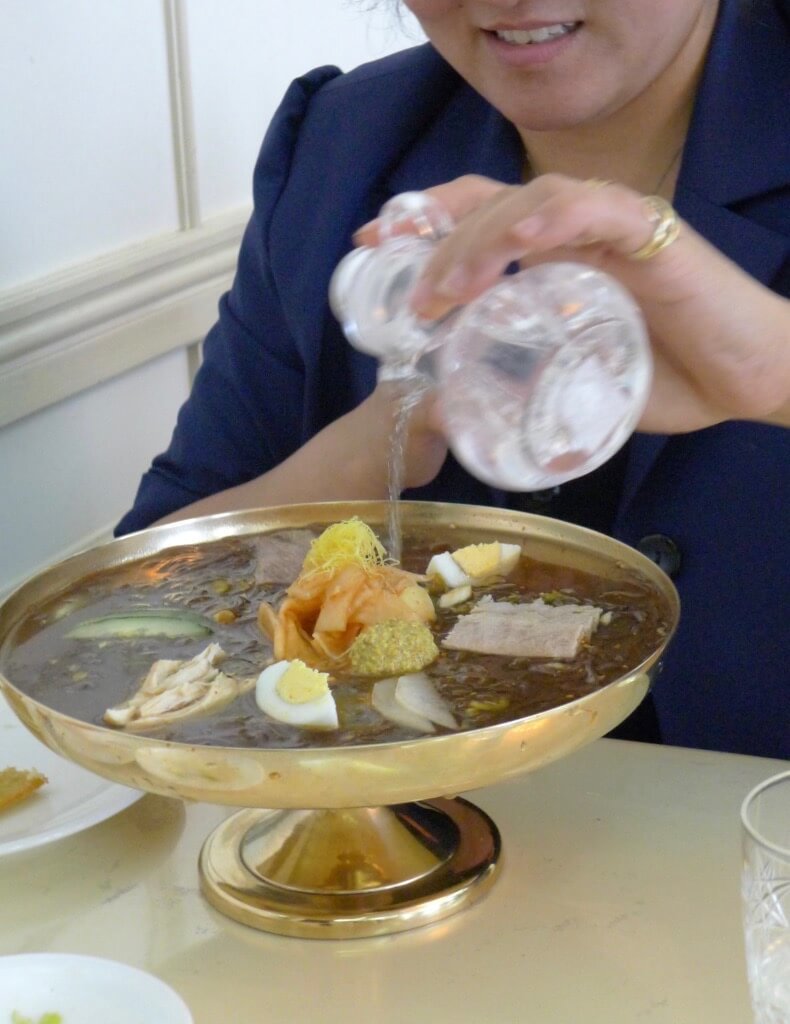
Adding some vinegar to Pyongyang Naengmyeon for extra tang.
Let's Eat Korea!
Despite Korea’s small size, it’s an incredibly diverse country geographically which has resulted in Korean cuisine also being as diverse as a result. Korean cuisine has been shaped by its geography, seasons and palates of its people.
Each region of Korea has its own specialities and versions of well-known classics. One of the greatest experiences of travelling the Korean peninsula is simply having the opportunity to try each region’s specialities! What better way to explore, understand and experience local cultures, then through your stomach.
A great example of the diversity in Korean cuisine is the ubiquitous Kimchi. While everyone that knows Kimchi is familiar with the spicy fermented Chinese cabbage dish, what many don’t know is that there are different versions of fermented Chinese cabbage Kimchi, and hundreds more different versions of Kimchi utilising the different vegetables & plants grown throughout Korea in each season.
For cold noodles, you will find local variations all over Korea with differences in what ingredients are used to make the noodles, broth, toppings and even the final presentation of the dish. Some serve it on ice, while others serve them without any broth at all. It is all largely based on the produce available locally, and the taste preference of the people from that region. Because of the earlier mentioned cure cold with cold food it should come as no surprise that the ingredients that make cold noodles are at their most plentiful and best during winter after the autumn harvest.
The Korean War saw a mass movement of people throughout the Korean peninsula as they escaped the fighting with many Koreans from the north finding themselves setting up new homes in South Korea. They longed for the taste of cold noodles from their home towns but were unable to get the necessary ingredients to make Pyongyang Naengmyeon or Hamhung Naengmyeon. They resorted to substituting ingredients with what was available to them at the time to create cold noodle spin-offs.
The best known of these spin-offs is a dish from Busan called milmyeon. It is a very similar dish to naengmyeon with the key difference being that regular wheat flour is used to make the noodles as buckwheat was unavailable to the migrants at the time.
The Science of Cold Noodles
Science plays an important part in cold noodles.
For cold noodles made with buckwheat, it is important to note that buckwheat contains no gluten. Despite its name buckwheat is not a type of wheat nor is it even related to wheat, it’s actually more closely related to sorrel and rhubarb. This is great news for celiacs and those with gluten disorders, but it does make it more challenging to make and cook buckwheat noodles without forgiving glutens inside.
To ensure your buckwheat noodles are all uniform and therefore cook evenly, a noodle press is an absolute must-have to ensure good quality noodles. The noodles are also best if cooked straight after being formed into noodles. There is no need to let any glutens rest like you would making other noodle dishes.
Looking at the process of cooking cold noodles you will notice that the noodles are cooked in hot water (for 80 seconds exactly) before being washed three times (always three times) in cold water.
What this process of taking the noodles from hot water into cold water does is stop the cooking process. The result is that the noodles are cooked to perfection and no more.
Even if you were to cook them and take them out of the hot water, the residual heat and steam from the noodles will continue to cook them and you will end up with overcooked, stodgy noodles which won’t taste very good at all.
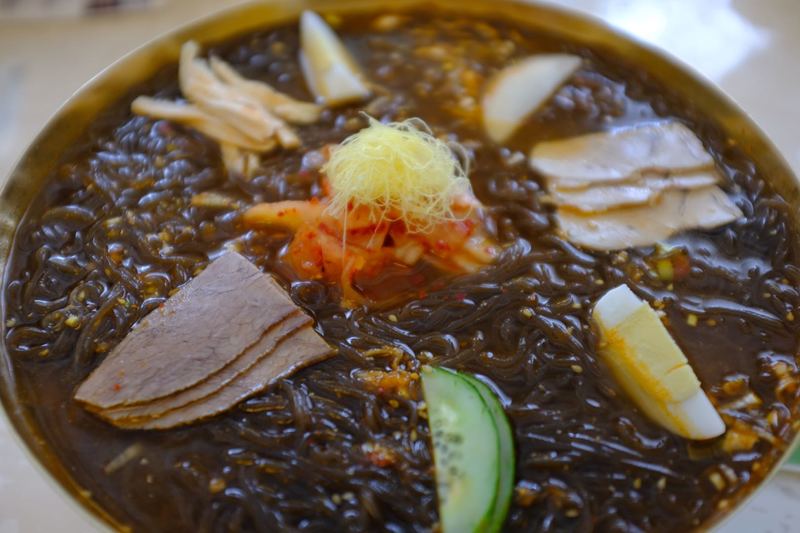
Cold noodle or Naengmyeon close up, for science
Pyongyang Naengmyeon is the Best
Regardless if they have tried them or not, chances are high that Koreans will say the best cold noodles are Pyongyang Naengmyeon, or possibly even Hamhung Naengmyeon due to how famous they are amongst Koreans.
Both are also quite different versions of cold noodles, which highlights the earlier discussed diversity of Korean cuisine.
Pyongyang Naengmyeon is a mul naengmyeon (soup cold noodle) style as it is served in a broth made of either beef or pheasant (mainly beef nowadays) and generally has a splash of radish Kimchi water in it. Its noodles are made from buckwheat and it is traditionally served with toppings of sliced beef, pork, chicken, cucumber, radish, Kimchi and half a boiled egg. Its taste can be a bit bland for some so any combination of vinegar, mustard or soy sauce can be added after serving to adjust the taste to suit the palate of the customer.
Hamhung Naengmyeon is a bibim naengmyeon (mixed cold noodle) style as it is served with no broth, but instead, the noodles are mixed in a spicy gochuchang (red pepper) dressing. Its noodles are made using potato starch instead of buckwheat which results in a glass-like noodle after cooking. Toppings include sliced pork, cucumber, radish, Kimchi, sesame and half a boiled egg. It can also be served with marinated raw fish on top, usually skate.
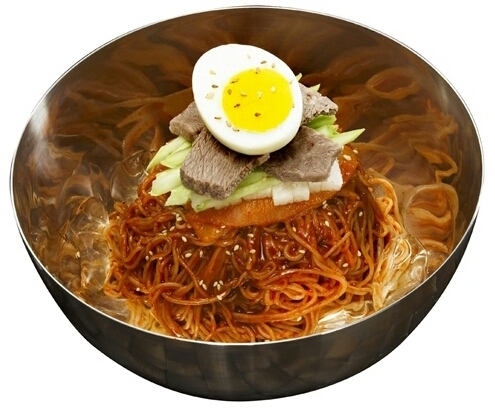
Bibim Naengmyeon of the same kind as Hamhung Naengmyeon
Photo: Korea.net via wikimedia commons
Warm Culture of Cold Noodles
Food and culture are heavily intertwined the world over. Cold noodles are no different, but beyond everyday culture cold noodles have broken out to play a part in music and even politics.
Looking at everyday culture Korean meals are traditionally served in a group setting with main meals being shared and at the end of the meal, everyone gets to enjoy their own dish (or as some call it, pre-dessert). This dish is usually a rice or noodle dish. Cold noodles, in particular, is a popular dish to finish one’s meal with. No doubt many memorable meals have been finished with cold noodles.
Of course, cold noodles can be a standalone dish and be the main course. Though it was originally enjoyed in wintertime, many people nowadays enjoy eating cold noodles on a hot summer day. While this goes against the idea of fighting heat with heat, the attraction is the same as if enjoying an icy pole on a hot summer’s day in that it’s a refreshing way to tackle the heat, though instead of a frozen ice block on a stick this is the main meal. Of course one can always add extra spicy ingredients to up the heat content if they wish to increase the heat content of their cold noodles.
In East Asia noodles are a symbol of longevity with cold noodles being traditionally served in Korea as the noodle dish of longevity for birthdays and in North Korea, marriage. Cold noodles and marriage are of particular note as not only as they consumed at the wedding party as a symbol of a long, happy marriage, but they are also used as a euphemism to ask someone when they are going to get married, the question being “when are you going to serve me your cold noodles?”. Get it? Good.
We Sing of Our Boundless Love of Cold Noodles
When food becomes song, transcending from plate into music, you know that its status in a culture is something special. Cold noodles are just one of those dishes that has been turned into music and has, so far, had two songs dedicated to it.
First, from North Korea, we have the song Pyongyang Naengmyeon is the Best. This song doesn’t mince around with any double meanings or anything like that - it is simply a song about how great Pyongyang Naengmyeon is and how much Koreans love to eat it. It’s catchy and a great song to sing on your way to eat naengmyeon.
From South Korea we have the song Naengmyeon. This one is a bit different as rather than singing about how good it is to eat cold noodles, it’s using them as an analogy for someone who gets the cold shoulder when confessing their feelings to the person they like, and thus becoming cold noodles.
It’s an even catchier song than the first that was originally made for a television show in 2009 and became a hit in South Korea at the time. The song is a duet between Korean entertainer Park Myung-Soo and Jessica Jung of k-pop super group Girl’s Generation. Such was its popularity Girl’s Generation went on to incorporate the song into their live performance. The song even has cold noodle eating incorporated into its dance routine!
Cold Noodles Becomes Warm Diplomacy
At the April 2018 inter-Korean summit between South Korean President Moon Jae In and North Korean leader Kim Jong Un held at Panmunjom on the border between the two Korea’s, cold noodles became the star of the event as Pyongyang Naengmyeon became a common and relatable thing not just between the two leaders, but also the two Koreas.
The two leaders had agreed ahead of the summit to share a meal together as part of the day’s events. Apparently Moon Jae In had asked if it would be possible to have Pyongyang Naengmyeon served at lunch which the North Korean’s dutifully agreed to. The top chef from Korea’s number one cold noodle restaurant Okryugwan was tasked with serving cold noodles to the leaders of the two Korea’s, but his task was reportedly difficult due to the need to get one of his noodle presses from the restaurant in Pyongyang to Panmunjom.
With assistance, the chef was able to overcome this challenge and Pyongyang Naengmyeon was served to the Korean leaders. North Korean leader Kim Jong Un later mentioned that it had been quite a challenge to get everything in place to serve Pyongyang Naengmyeon at the summit.
Thus cold noodle diplomacy was born – a kind of soft political power with food being the centre of attention.
Seeing the two leaders enjoying cold noodles together created quite a stir, particularly in South Korea with people all over suddenly craving them and heading to their nearest cold noodle restaurant for a bowl only to find they had to wait in line as everyone else had the exact same thought.
In September 2018 cold noodle diplomacy was again centre stage at the inter-Korean summit in Pyongyang. This time the two leaders were to have multiple meetings and events over three days to forge an agreement on inter-Korean relations moving forward. One of their meals together was at the Okryugwan restaurant on the banks of Taedong River, with footage of Moon Jae In getting his fill of Pyongyang Naengmyeon again inspiring South Koreans to eat cold noodles and generating good business for naengmyeon restaurants all over the country.
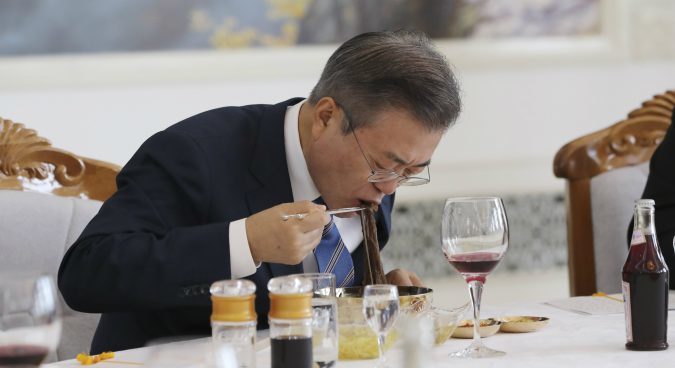
South Korean President Moon Jae In getting into a bowl of Pyongyang Naengmyeon at Okryugwan in Pyongyang
Photo: Pyongyang Press Corps via NK News
I Want to Eat Cold Noodles
All this talk of food naturally makes one hungry, and hopefully, you are ready to eat a fresh bowl of cold noodles.
There are several options on how to get your fill of cold noodles with the easiest being to hit up your local Korean restaurant. While it is easy, do be aware there is a chance they will serve either a different regional version or even a different cold noodle dish as opposed to the real thing that we’ve talked about here. Believe it or not, cold noodles has cold cousins that the uninitiated would easily get mixed up with, though they are worth your time nonetheless.
Another way to get your cold noodle fix is to try making them yourself. We have previously published a recipe for making Pyongyang Naengmyeon here. It is a time-consuming dish to make so ensure you have everything you need prepared and ready to go.
If you are fortunate to have a Korean supermarket nearby then you can find various cold noodle components ready to go as convenient short cuts, and even complete cold noodle kits so you can enjoy cold noodles at home without the fuss.
Our favourite way to eat cold noodles though is to make the trek to Korea. You don’t necessarily need to go to North Korea as there are many South Korean cold noodle restaurants, with some even specialising in serving naengmyeon in the Pyongyang or Hamhung styles.
But if you want to want to eat the real thing in the home of cold noodles then there is only one thing to do – book a trip to North Korea. There are many opportunities to eat Pyongyang Naengmyeon in Pyongyang with all restaurants serving it.
If you really want to eat Pyongyang Naengmyeon then you really must go to Okyrugwan. It is Pyongyang’s most famous restaurant because their cold noodles are considered the best. Local Koreans line up here for hours on some days just to get their fill of Okryugwan’s naengmyeon. It’s a wait they say makes the noodles even more delicious – we say it’s clever marketing.
We include Okryugwan on most of our tours due to its cultural significance. The cost to visit here to try cold noodles can be included in your tour fee. If you’re planning a private tour then don’t hesitate to request a meal here.
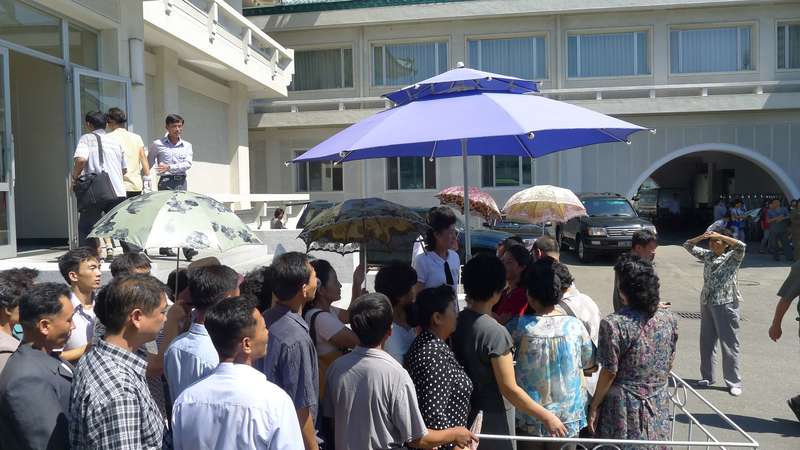
Pyongyangites making their naengmyeon even tastier by waiting in line to enter Okryugwan
Let's Finish with Cold Noodles
Like the end of a great meal, we’re going to finish this article with cold noodles.
This time we have this cooking video from North Korea which details the process for making Pyongyang Naengmyeon.
This marks the end of our love letter to cold noodles. Who would have thought a simple dish of cold noodles could not only be appetising, but also become a food so powerful it has people singing about it and politicians making peace over them.